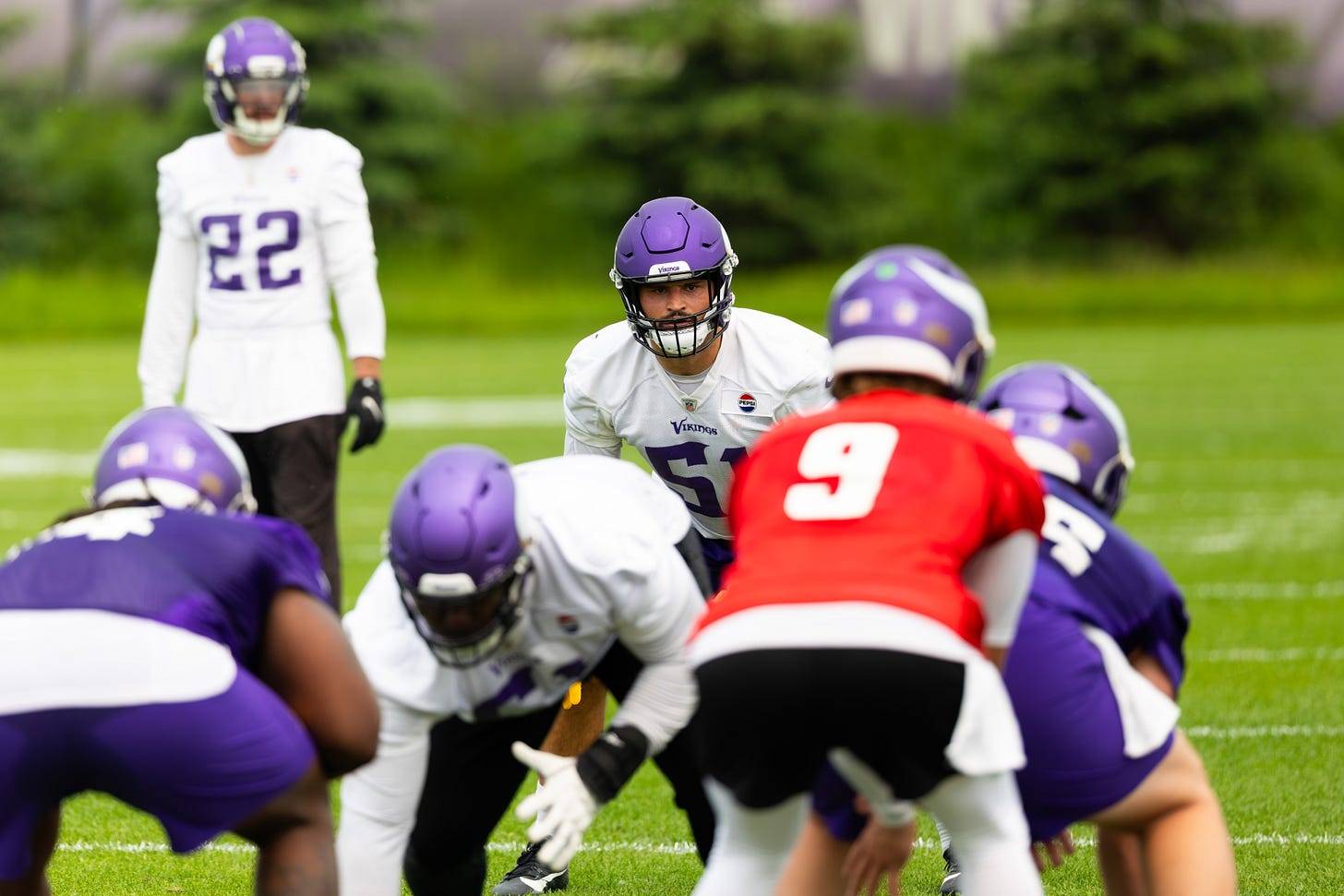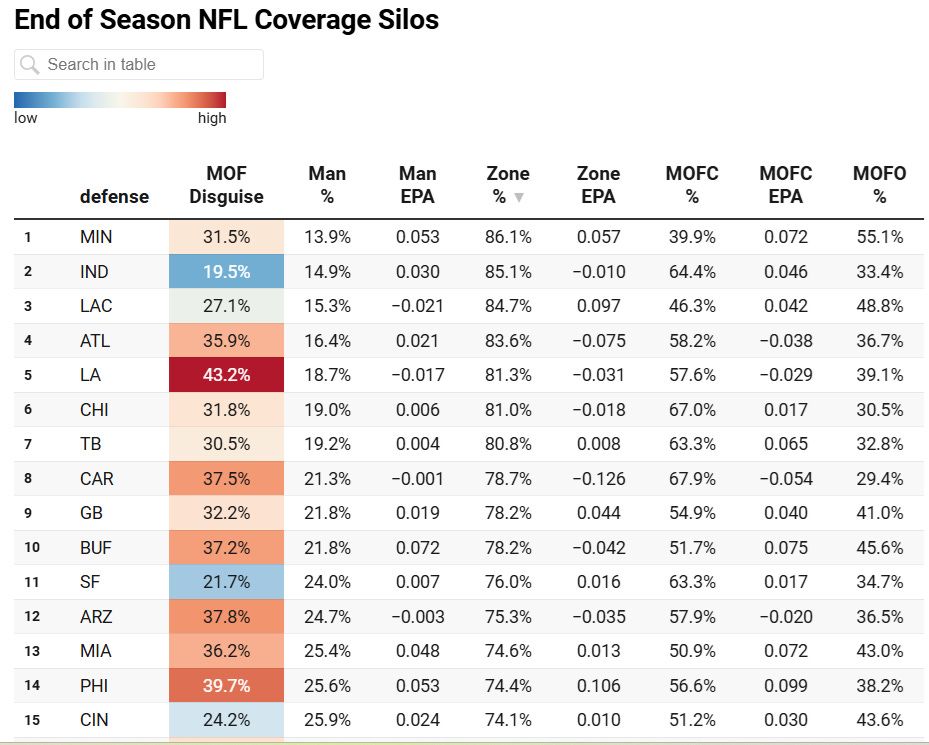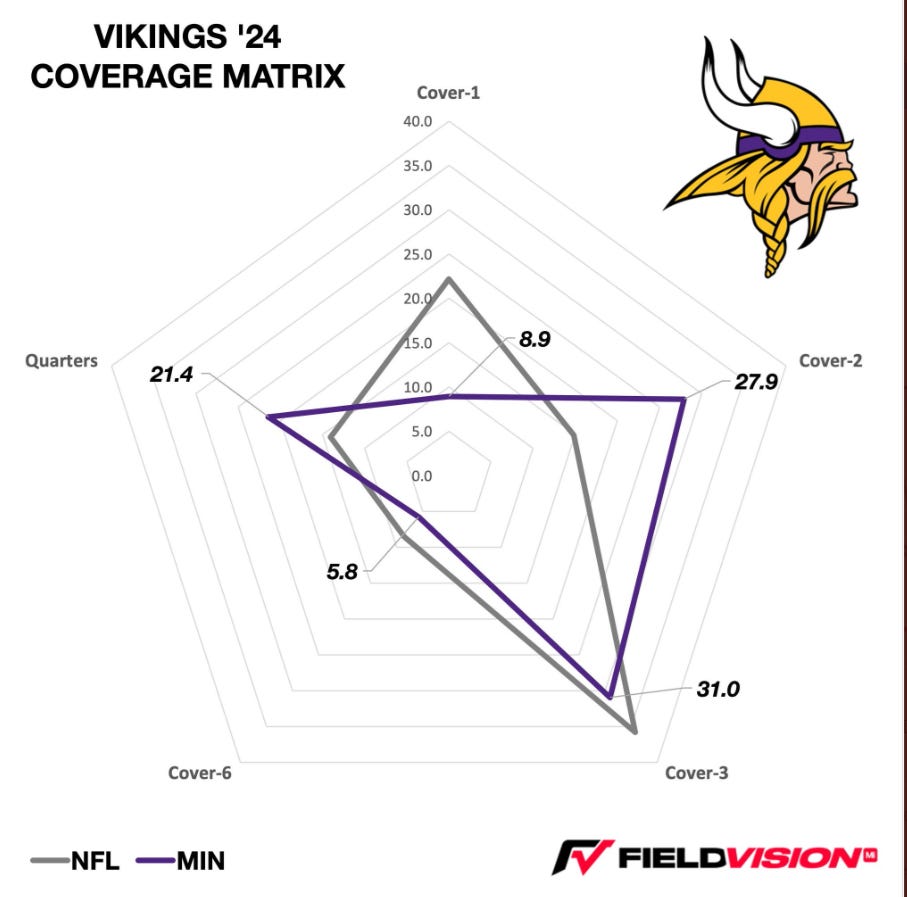Will the Vikings keep leading the zone coverage trend in the NFL?
Brian Flores, Blake Cashman, Andrew Van Ginkel and Byron Murphy Jr. talked about why the Vikings have been so good as a zone defense
By Matthew Coller
EAGAN — One of the things that makes football great is that the game is always changing. Every year there are new trends and power shifts between offense and defenses based on who has the latest invention. Last year, there was a lot of talk about dominating run games returning, especially in Philly and Baltimore. We also saw the official rise of the greatest force on defense: The interior pass rush.
Something that has been a little bit more slow developing around the NFL is the increase in how often defenses are playing in zones rather than matching up in man-to-man coverage.
“There's a lot of really good receivers, a lot of really good quarterbacks, a lot of really good coordinators, it's hard to line up and play man-to-man coverage, play after play after play,” Flores said on Monday. “I think people are trying to limit explosive plays and just try to keep it in front of you. So that's generally why I think there might be a little bit more zone coverage.”
It shouldn’t come as a surprise that innovator Brian Flores has pushed the zone coverage trend to the extreme, playing in zone more often than any other team in the NFL in 2024 at 86.1% of the time, per Field Vision Sports.
Why did the Vikings play so much zone last year? Why did it work so well for the Vikings?
When Kevin O’Connell hired Flores as his defensive coordinator, he talked about how he appreciated B-Flo’s aggressive philosophy. According to Pro-Football Reference, the Vikings sent at least five rushers on 38.9% of snaps, No. 1 in the NFL. The zones that the Flores deploys behind the extra rush are meant to cause an extra beat of hesitation from the opposing QB, allowing the rush to get there.
“I feel like in zone coverage especially with how we do things it allows you to create a lot of disguises and confusion for an offense whereas with man [coverage] it’s a little bit easier to diagnose that,” Cashman said.
“You could go out there and play man-to-man every single snap if you wanted to but if you show opponents different schemes then it’s going to mess up the flow of the offense and make the quarterback think a little bit more,” cornerback Byron Murphy Jr. said. “I like playing man because I want to go guard the best receiver but zone makes the quarterback go through all his reads.”
Cashman played the 9th highest percentage of zone coverage of any linebacker in the league, per PFF. Murphy Jr. had the 11th highest among corners.
Zones are also an answer to creative offenses, who have gotten more and more clever about moving their star players around. Last year there were 64 receivers (min. 30 targets) who played at least 30% of their snaps in the slot. Offenses are using bunch formations and motions to get free releases from the line of scrimmage from their stars and prevent the opposition from letting cornerbacks “travel” with their top WR. This has changed even since 2017 when the Vikings used Xavier Rhodes to lock down Antonio Brown, Mike Evans and Julio Jones.
“Those [offensive] coaches coming up with these schemes and plays, they’re going to do everything they can to get their playmakers space and make it more challenging for the defense,” Cashman said. “A lot times now when you’re in man coverage they try to open up a quick window and get a quick throw and let those guys pick up YAC with their legs.”
The other part of leaning into zones, in particular cover-4 and cover-2 for the Vikings, is that they have a group of players with the intelligence and experience to handle the mental load that comes along with zones. Rather than just covering one receiver all over the field, defenders must understand all the moving parts on both sides of the ball.
“There is a lot of knowledge that goes into it,” outside linebacker Andrew Van Ginkel said. “You have to have an understanding of concepts, what we’re trying to get accomplished, having an understanding of who the offense is, who they have at certain positions and how they are trying to get them the ball. Offenses are always trying to feature their best players and trying to get them going, so if you can understand different ways they target those guys.”
A nose for the football is also a prerequisite.
“You have to be a ball hawk to go get it, read the quarterback and go get the ball,” Murphy Jr. said.
In the personnel department, the Vikings were so intent on drafting Dallas Turner in the first round last year in part because they felt he could become more than just an edge rusher. In college he dropped back into coverage occasionally and last year he was in coverage on 55 of his 302 snaps.
“That’s defensive football is moving in that direction where edge guys are dropping, corners are playing some safety spots, safeties playing in corner spots, and so on and so forth, if they can handle it,” Flores said.
Last year Van Ginkel played more snaps in coverage than any other edge player in the league so Turner is spending time this offseason studying his dynamic teammate.
“Seeing what 43 does every day and on gameday, you just want to walk in those footsteps,” Turner said. “Being attentive in the film session….Getting familiar with offensive recognition, formations, plays, different types of shifts,” Turner said. “Playing faster, I feel like that’s something I could have done a lot more last season and not being afraid to make mistakes.”
While the linebackers are the same, one area where the Vikings personnel is different this year is at cornerback. Some of the extreme lean toward cover-2 and cover-4 may have been to protected the well-traveled Stephon Gilmore (9th in zone coverage rate) and veteran Shaq Griffin from being attacked one-on-one by offenses.
Now the Vikings have a new starter in Isaiah Rodgers, who was the highest PFF graded cornerback in man coverage last year with at least 200 coverage snaps. Historically Rodgers has played more zone than man coverage but his blazing speed would seem to give Flores the option of having him travel with a wide receiver.
“Isaiah Rodgers to me is a guy that, he's here for a reason and he's already demonstrated why we really wanted to bring him here,” O’Connell said. “Probably one of the faster players on our team, ultra consistent, confident, just never, never off balance, never panics. And I think that's gonna bode really well when you pair that skill set outside with the way we can pressure the quarterback.”
While Flores has clearly identified players who can drop into zones effectively, he was quick to point out that you can’t always rely on deceiving quarterbacks. Sometimes it’s a mono-a-mono game.
“I think when you're evaluating corners, when you get down to those critical, critical plays, you can sneak a couple zones in there, but inevitably you're going to have to place of man coverage,” Flores said. “So that's still a big part of the evaluation corners, I would say. But their ability to play zone, high-to-low, ball skills, [be able to play] a variety of coverage and coverage spots.”
The defensive line could impact the percentage of zones as well. This offseason the Vikings signed two of the better interior rushers over the last decade in Javon Hargrave and Jonathan Allen, giving them more options to rush four rather than having to blitz in order to create pressure up the middle.
If the Vikings plan to use Jeff Okudah as their starter in nickel packages, which is how he was deployed over the first four days of camp, then there are arguments for him as a man corner against bigger receivers or that he might fit better into zones where he can bump receivers off their track at the line of scrimmage and rally to the football as an above average tackler and run defender. There was an example of Okudah’s size in a zone coverage making a difference.
“The one turnover JJ's had and went that off the tip ball to Harrison, that was off of a hard reroute from Okudah and then timing the play got thrown off and we're kind of off our footwork and the read progression were just totally thrown off because one guy jammed,” O’Connell said.
In a copycat league, that’s something quarterback JJ McCarthy now has to plan for as well. Five years ago, there were 35 full-time corners who played at least 35% of their snaps in man coverage (per PFF). Last year only 16 CBs played more than 35% and only six were over 40% and they all came from either Detroit or New England.
What does that mean? Outside of diagnosing coverage disguises, McCarthy will have to throw the ball into certain types of windows rather than just trying to hit a man open in one-on-one coverage.
“A lot of times you're throwing through open voids,” O’Connell said. “Luckily our defense, the way they play and some of the things…they are doing are forcing some of those throws.”
Flores points out, however, that the zone coverage trend may be en vogue right now but offenses had an entire year to evaluate how to defeat zones. It might not be that way this year.
“Every year there's different trends,” Flores said. “We try to stay up on the different trends, the different, what's involved offensively and defensively, just to see if there's something that we can add or something we have to get get ready for. So in previous years, it's been zone coverage. But oftentimes when you an offense expect something, you want to give them something different. So maybe this year it's all man coverage. So who knows?”




Love these kinds of articles that give you a bit of a deeper dive into the schemes they’re running. It will be interesting to see if they run a little more man with Rodgers this year if that is his strength. Ideally, you’d like it if they can keep the same scheme as last year against the younger QBs that really struggled against it and then be able to change it up against the more experienced QBs when needed. I don’t know that man will get you any farther than zone against Burrow and the rest of the elite QBs, but definitely felt last year like they needed something different scheme wise against a few of the older vets.